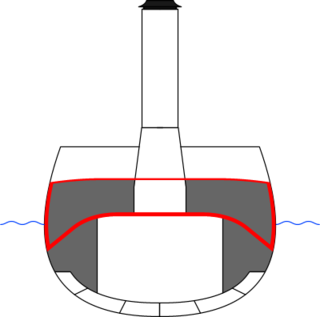USS Washington may refer to:
Ships named in honor of George Washington:
- USS Washington (1775) was a schooner acquired in October 1775 and captured by the Royal Navy in December the same year
- USS Washington (1776 row galley) was a row galley acquired in January 1776 with an unknown fate after August the same year
- USS Washington (1776 frigate) was one of 13 frigates authorized by the Continental Congress, launched in August 1776; and scuttled in November 1777 to prevent capture
- USS Washington (1776 lateen-rigged galley) was a galley built and subsequently captured by the Royal Navy in October 1776
- USS Washington (1814) was a ship of the line on active service from 1815 to 1820
- USRC Washington (1833) was a revenue cutter launched in 1833 and sold in June 1837
USS Washington was a schooner acquired by the Continental Navy during the American Revolution and converted to an armed brigantine. She served for only a short period of time before being captured by the British.
A schooner is a type of sailing vessel with fore-and-aft sails on two or more masts. The most common type has two masts, the foremast being shorter than the main. While the schooner was originally gaff-rigged, modern schooners typically carry a Bermuda rig.
USS Washington was a large row galley, with a rowing crew of 60, that was placed into service under the control of the Continental Congress in 1776. During this age of sail, row galleys were highly maneuverable compared to sailing ships whose movements were dependent on the wind. Washington's war record consisted of an attack on several British warships, and, after finding itself on the losing side of the battle, the row galley rowed away, out of danger. There is no further report of her efforts for the Continental Navy.
Ships or boats named in honor of the State of Washington

Washington, officially the State of Washington, is a state in the Pacific Northwest region of the United States. Named for George Washington, the first president of the United States, the state was made out of the western part of the Washington Territory, which was ceded by Britain in 1846 in accordance with the Oregon Treaty in the settlement of the Oregon boundary dispute. It was admitted to the Union as the 42nd state in 1889. Olympia is the state capital; the state's largest city is Seattle. Washington is sometimes referred to as Washington State, to distinguish it from Washington, D.C., the capital of the United States, which is often shortened to Washington.
- USS Washington (ACR-11) was a Tennessee-class armored cruiser, launched in 1905, renamed Seattle in 1916, reclassified as a heavy cruiser in 1920; and scrapped 1946
- USS Washington (BB-47) was a Colorado-class battleship launched in 1921 and sunk as a gunnery target in 1924 after her construction was halted in 1922
- USS Washington (BB-56) was a North Carolina-class battleship launched in 1940, decommissioned in 1947, and scrapped in 1961
- USS Washington (SSN-787) is a Virginia-class submarine

The seventh USS Washington (ACR-11/CA-11/IX-39), also referred to as "Armored Cruiser No. 11", and later renamed Seattle and reclassified CA-11 and IX-39, was a United States Navy Tennessee-class armored cruiser. She was laid down on 23 September 1903 at Camden, New Jersey, by the New York Shipbuilding Corporation, launched on 18 March 1905, sponsored by Miss Helen Stewart Wilson, daughter of United States Senator John L. Wilson of Washington state, and commissioned at the Philadelphia Navy Yard on 7 August 1906, Captain James D. Adams in command.

The Tennessee-class cruisers were four armored cruisers built for the United States Navy between 1903 and 1906. Their main armament of four 10-inch (254 mm) guns in twin turrets was the heaviest carried by any American armored cruiser. Their armor was thinner than that of the six Pennsylvanias which immediately preceded them, a controversial but inevitable decision due to newly imposed congressional restraints on tonnage for armored cruisers and the need for them to be able to steam at 22 knots. However, the fact their armor covered a wider area of the ship than in the Pennsylvanias and their increased firepower caused them to be seen by the Navy as an improvement.

The armored cruiser was a type of warship of the late 19th and early 20th centuries. It was designed like other types of cruisers to operate as a long-range, independent warship, capable of defeating any ship apart from a battleship and fast enough to outrun any battleship it encountered. Varying in size, it was distinguished from other types of cruiser by its belt armor—thick iron plating on much of the hull to protect the ship from shellfire much like that on battleships. The first armored cruiser, the Imperial Russian Navy's General-Admiral, was launched in 1873 and combined sail and steam propulsion. By the 1890s cruisers had abandoned sail and took on a modern appearance.
Others
- USRC Washington (1837), was a revenue cutter named after Peter G. Washington, Assistant Secretary of the Treasury. The ship was launched in 1837 and seized by Confederate Navy in June 1861.
- Washington (SP-1241), was a United States Navy seagoing coal barge during 1917

Washington (SP-1241) was a seagoing schooner barge that served in the United States Navy in 1917.

